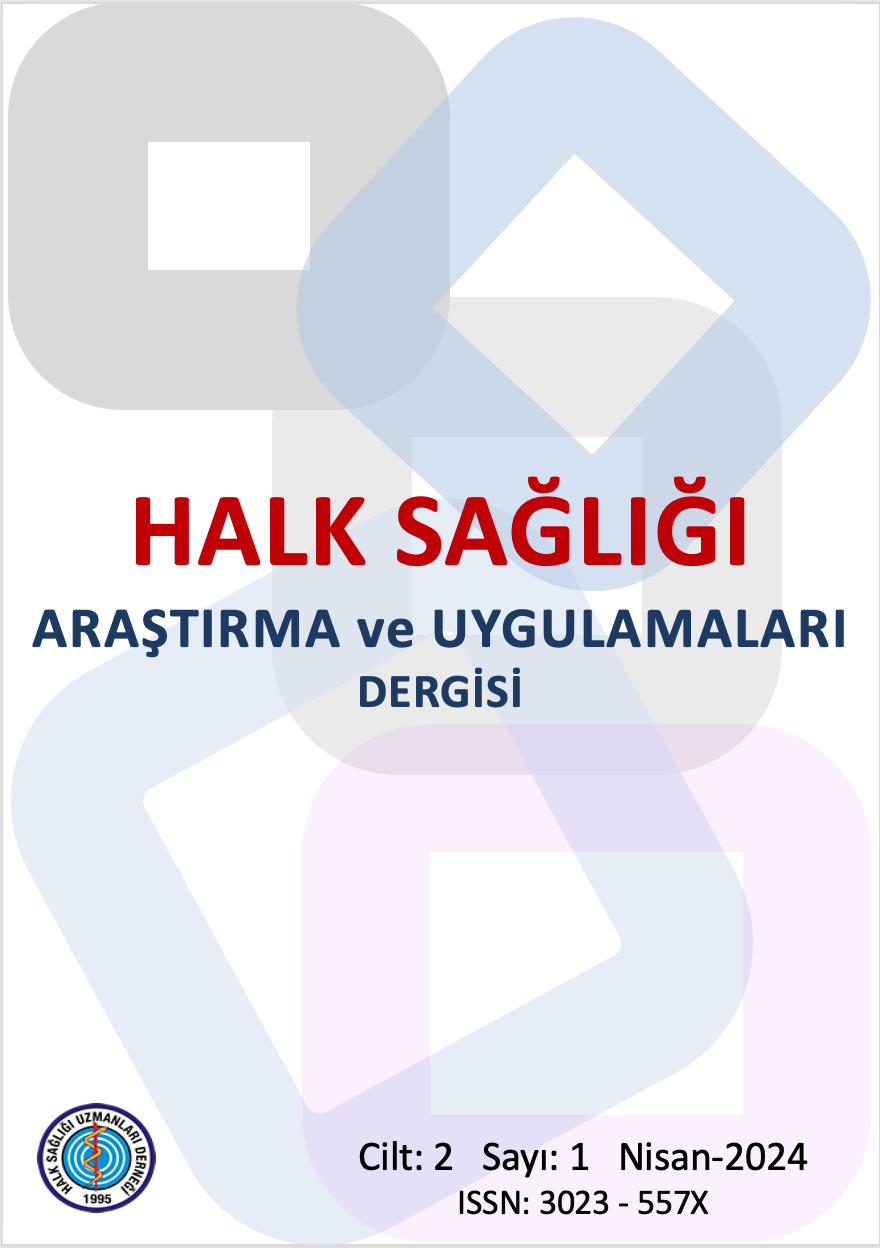The impact of health service indicators and socioeconomic factors on infant mortality rate in Türkiye: Provincial-level ecological analysis
DOI:
https://doi.org/10.5281/zenodo.11047017Keywords:
Infant Mortality Rate, Social Determinants of Health, Ecological Study, Health System, EquityAbstract
In Türkiye, the infant mortality rate (IMR) has consistently exceeded expectations based on the country’s economic level and other development indicators for many years. This study aims to determine the effect of socioeconomic factors and healthcare indicators on infant mortality rates among provinces in Turkey. This is an ecological study. The data were obtained from the Turkish Healthy Cities Association and the Turkish Statistical Institute publications, and include socioeconomic and healthcare indicators for the year 2011 for 81 provinces of Türkiye. The variables of the study are infant mortality rate, number of physicians per 100.000 individuals, number of nurses per 100.000 individuals and hospital beds per 100.000 individuals, income per capita, ratio of female illiteracy, net migration rate, labor force participation rate, and unemployment rate. Statistical evaluations involved correlation, linear regression analysis. Ağrı, Siirt and Tokat are the provinces with the highest IMR. When evaluating inequalities at the provincial level, the Southeastern provinces of Türkiye had the worst values. The highest inequality ratio is observed in the ratio of female illiteracy (6.6 times) among all variables. Among health service indicators, the inequality ratio is highest in the density of hospital beds (5.9 times). A significant correlation was observed between IMR and all variables. According to the results of regression analysis, the model that best explains the regional disparities in IMR with the fewest variables was constructed using income, the total number of nurses per hundred thousand individuals, and the labor force participation rate. In explaining the variations in IMR among provinces in Türkiye, the number of hospital beds was found to have no significant influence, while the number of physicians and nurses were found to be significantly influential. To reduce infant deaths, increasing the number of nurses and eliminating distribution inequalities between provinces are crucial. Furthermore, initiatives to enhance income opportunities should be planned, and labor force participation should be increased.
References
Hacettepe Üniversitesi Nüfus Etütleri Enstitüsü. Türkiye’nin Demografik Dönüşümü. Ankara, 2010. https://fs.hacettepe.edu.tr/hips/dosyalar/yayinlar/2010_TurkiyeninDemografikDonusumu.pdf
OECD. Health at a Glance 2013: OECD Indicators, OECD Publishing, 2013. https://www.oecd.org/els/health-systems/Health-at-a-Glance-2013.pdf
United Nations Türkiye [İnternet]. https://turkiye.un.org/en/sdgs/3#:~:text=Goal%203%20Targets&text=3.2%20By%202030%2C%20end%20preventable,25%20per%201%2C000%20live%20births.
Dallolio L, Di Gregori V, Lenzi J, et al. Socio-economic factors associated with infant mortality in Italy: an ecological study. Int J Equity Health. 2012;11:45. doi: 10.1186/1475-9276-11-45.
Damghanian M, Shariati M, Mirzaiinajmabadi K, et al. Socioeconomic inequality and its determinants regarding infant mortality in Iran. Iran Red Crescent Med J. 2014;16(6):e17602. doi: 10.5812/ircmj.17602.
Lin SJ. The effects of economic instability on infant, neonatal, and postneonatal mortality rates: evidence from Taiwan. Soc Sci Med. 2006;62(9):2137–50. doi: 10.1016/j.socscimed.2005.10.013.
Mahy M. Childhood mortality in the developing world: a review of evidence from the demographic and health surveys. Calverton, Maryland, USA, 2003. https://dhsprogram.com/pubs/pdf/CR4/CR4.pdf
UNICEF. Levels & Trends in Child Mortality Report 2013. New York, ABD, 2013. https://data.unicef.org/resources/levels-trends-child-mortality-report-2013/
Zanini RR, Moraes AB de, Giugliani ERJ, et al. Infant mortality trends in the State of Rio Grande do Sul, Brazil, 1994-2004: a multilevel analysis of individual and community risk factors. Cad Saúde Pública. 2009;25(5):1035–45. doi: 10.1590/s0102-311x2009000500010.
Özdemir P, Karabulut E. İl ve bölgelere göre bebek ölüm hızlarındaki değişkenliğin Gini eşitsizlik ölçüsü ile incelenmesi: sağlık alanındaki eşitsizliklerin değerlendirmesi. Türkiye Klinikleri J Biostat [İnternet]. 2009;1(2):45–53. https://www.turkiyeklinikleri.com/article/tr-il-ve-bolgelere-gore-bebek-olum-hizlarindaki-degiskenligin-gini-esitsizlik-olcusu-ile-incelenmesi-saglik-alanindaki-esitsizliklerin-degerlendirmesi-55790.html
Gürsoy-Tezcan A. Infant mortality: a Turkish puzzle? Health Transit Rev [İnternet]. 1992;2(2):131–49. https://pubmed.ncbi.nlm.nih.gov/10148654/
Hacettepe Üniversitesi Nüfus Etütleri Enstitüsü. Türkiye Nüfus ve Sağlık Araştırması 1983. Ankara, Türkiye, 1987. https://www.halksagligiokulu.org/Kitap/DownloadEBook/90890c89-5e36-4139-896e-c355e7797960
Hacettepe Üniversitesi Nüfus Etütleri Enstitüsü. Türkiye Nüfus ve Sağlık Araştırması 1993. Ankara, Türkiye, 1994. https://fs.hacettepe.edu.tr/hips/dosyalar/Ara%C5%9Ft%C4%B1rmalar%20-%20raporlar/1993%20tnsa/93_mainreport.pdf
Hacettepe Üniversitesi Nüfus Etütleri Enstitüsü. Türkiye Nüfus ve Sağlık Araştırması 2003. Ankara, Türkiye, 2004. https://fs.hacettepe.edu.tr/hips/dosyalar/Ara%C5%9Ft%C4%B1rmalar%20-%20raporlar/2003%20tnsa/TNSA_2003_ana_rapor.pdf
Hacettepe Üniversitesi Nüfus Etütleri Enstitüsü. Türkiye Nüfus ve Sağlık Araştırması 2013. Ankara, Türkiye, 2014. https://fs.hacettepe.edu.tr/hips/dosyalar/Ara%C5%9Ft%C4%B1rmalar%20-%20raporlar/2013%20tnsa/TNSA_2013_ana_rapor
T.C. Sağlık Bakanlığı Sağlık Bilgi Sistemleri Genel Müdürlüğü (2023). Sağlık İstatistikleri Yıllığı 2022 Haber Bülteni [İnternet]. https://sbsgm.saglik.gov.tr/Eklenti/46511/0/haber-bulteni-2022-v7pdf.pdf?_tag1=3F123016BE50268AF4A10917870BF5962AC79ECF
TÜİK (2014). http://tuikapp.tuik.gov.tr/ulusalhesapapp/bolgeselgskd.zul (Son erişim tarihi: 01.07.2015).
Türkiye Sağlıklı Kentler Birliği (2014). Türkiye Kent Sağlık Göstergeleri. http://www.skb.gov.tr/wp-content/uploads/2013/12/skb-100-246-2.pdf
Günay T, Kılıç B, Keskinoğlu P, et al. Infant mortality rates in Narlıdere district, Turkey (1999 to 2001): trends in rates and risk factors. Turk J Public Health [İnternet]. 2008;6(1):9–18. https://dergipark.org.tr/tr/pub/tjph/issue/16585
Schell CO, Reilly M, Rosling H, et al. Socioeconomic determinants of infant mortality: a worldwide study of 152 low-, middle-, and high-income countries. Scand J Public Health. 2007;35(3):288–97. doi: 10.1080/14034940600979171.
Mishina H, Hilton JF, Takayama JI. Trends and variations in infant mortality among 47 prefectures in Japan: variations in infant mortality in Japan. J Eval Clin Pract. 2013;19(5):249-254. doi: 10.1111/j.1365-2753.2012.01862.x.
Anand S, Bärnighausen T. Human resources and health outcomes: cross-country econometric study. The Lancet. 2004;364(9445):1603–9. doi: 10.1016/S0140-6736(04)17313-3.
Papastergiou P, Rachiotis G, Polyzou K, et al. Regional differences in mortality in Greece (1984–2004): the case of Thrace. BMC Public Health. 2008;8:297. doi: 10.1186/1471-2458-8-297.
Amiri A, Vehvilainen-Julkunen K, Solankallio-Vahteri T, Tuomi S. Impact of nurse staffing on reducing infant, neonatal and perinatal mortality rates: Evidence from panel data analysis in 35 OECD countries. International Journal of Nursing Sciences. 2020;7(2):161-9. doi: 10.1016/j.ijnss.2020.02.002
Muldoon KA, Galway LP, Nakajima M, et al. Health system determinants of infant, child and maternal mortality: a cross-sectional study of UN member countries. Globalization and Health. 2011;7:42. doi: 10.1186/1744-8603-7-42
Dilli D, Köse MR, Gündüz RC, et al. Recent declines in infant and neonatal mortality in Turkey from 2007 to 2012: impact of improvements in health policies. Cent Eur J Public Health. 2016;24(1):52–7. doi: 10.21101/cejph.a4097.
Mushtaq A, Mohsin A, Zaman K. Effects of health on changing labor force participation in Pakistan. SpringerPlus. 2013;2(1):610. doi: 10.1186/2193-1801-2-610.
TÜİK (2023). İşgücü İstatistikleri. https://data.tuik.gov.tr/Bulten/Index?p=Isgucu-Istatistikleri-2022-49390
Gençtürk Z. Türkiye’de kadının işgücüne katılımını etkileyen faktörler. Süleyman Demirel Üniversitesi Sosyal Bilimler Enstitüsü Dergisi. 2022/2;43:361-94. https://dergipark.org.tr/tr/pub/sbe/issue/72400/971424
Dinçer MA, Kaushal N, Grossman M. Women’s education: harbinger of another spring? evidence from a natural experiment in Turkey. World Development. 2014;64:243–58. doi: 10.1016/j.worlddev.2014.06.010
Downloads
Published
How to Cite
Issue
Section
License
Copyright (c) 2024 HALK SAĞLIĞI ARAŞTIRMA VE UYGULAMALARI DERGİSİ

This work is licensed under a Creative Commons Attribution-NonCommercial 4.0 International License.


